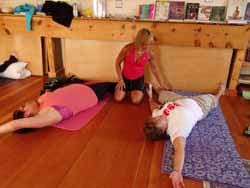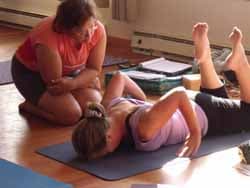To See or Not to See – That is the Question
by Mugs McConnell SOYA, ERYT500, IYTA
Back in 1978 I did my initial yoga teacher training at the Sivananda Ashram in the Bahamas. Swami Vishnudevananda and his disciples worked diligently to train us in the science of yoga philosophy as well as the skills of being a teacher of asana. Every day we practiced the Sivananda sequence, memorizing how to lead someone in the surya namaskar (sun salutation) without doing it with them, observing if a student’s shoulders were up by their ears in bhujangasana (cobra), and if toes and knees were aligned with the hip in janu sirsasana (head to knee pose). I worked hard to sharpen my observation skills and develop the ability to assist a student in finding relaxation within the alignment of a pose.
When I left the ashram I ventured out to attend classes with other teachers from other lineages. One day the teacher was doing the class along with the students. She was a full participant in the class. I thought to myself, “Why didn’t I think of that? All this time I have been watching my students do the asanas when I could have been doing the yoga with them and getting in my personal practice at the same time!” I decided to give this time-saving practice a try!
Fortunately, it wasn’t long before I picked up a Yoga magazine and read an article on this very topic – yoga teachers were becoming too busy to find time to do their own personal practice. Their solution was to participate alongside their students and do the class with them. The concern of course, is who then is watching the students? Who is seeing to their proper alignment and responding to their progress? Who is noticing if they are able to follow the verbal cues correctly? Who is noticing facial expressions to see if someone is injured or in pain? This is the job of the yoga teacher.
The article came just in time! I was just about to change my habit of leading my class to becoming a participant in my class. Saved by the bell! Ever since then I have kept my personal practice completely separate from when I teach so I can focus on giving my time and attention to the students.
This brings to mind a great quote from yoga master Erich Schiffmann that speaks volumes of our task as teachers.
“The purpose of yoga is to facilitate the profound inner relaxation that accompanies fearlessness. The release from fear is what finally precipitates the full flowering of love. In this state you will love what you see in others, and others will love you for having been seen. This is the softened perception of the world that yoga promotes.”[i]
Let’s take a look at some key words in here.
“Facilitate”
Our job as teachers is to help facilitate, meaning “to make easier or less difficult – to assist the progress of a person”[ii]. How can we do this if we cannot see the students? There are two key ways to facilitate the progress of your students. One is to demonstrate all new and major poses, pointing out the correct alignment and ways to modify the pose to make it easier or more challenging before the students gets into the pose. The second way to facilitate the progress of your students is to observe them while they are doing the poses. Seeing each and every one of them, and moving around the class if our view is obstructed. This way we can see if they have understood our cues and demonstrations, and if they need assistance to find the safest and most stable alignment in the pose.
This leads me into the next set of key words in the quote from Erich Schiffmann.
“You will love what you see in others…”
How beautiful that is to look at our students and see not only their progress but also our own. It is a gift to notice  how they have responded to our words and learn how skilled we are at helping them to find relaxation in the asana through correct alignment and personal modifications.
how they have responded to our words and learn how skilled we are at helping them to find relaxation in the asana through correct alignment and personal modifications.
If we put ourselves in the shoes of our students, the suggestion to “modify the pose as you need” really has little meaning. A new student may not even consider lowering their hands to their hips in virabhadrasana (warrior) to accommodate their shoulder injury if they have never been shown this modification. Potentially they could simply believe they can’t do the pose at all. However, once taught how to modify to accommodate the shoulders, the student benefits from the strengthening of the core and legs while working on their balance.
Our students show up at class ready to follow our guidance and instructions. Our ability to modify the asanas for them is directly related to their fear – fear of not being able to do yoga well enough, fear of failure, fear of pain. Each time we facilitate a student in finding the place of sthira and sukha or stability with ease, we succeed in removing another layer of their fear and reveal a greater feeling of success. In the words of Mr. Schiffmann, we “facilitate the profound inner relaxation that accompanies fearlessness,” which is the purpose of yoga.
And now for the last key words in the quote from Mr. Schiffmann.
“Others will love you for having been seen.”
Our students will love us for noticing them, for helping them to relax into their yoga practice, for guiding them to the options they never thought of. When we look at them and really see them, they feel noticed. They know that we care and we know they are there. They begin to trust that we will offer them guidance and assistance if they need it. They will want to show up for us and for themselves. They will feel loved. It may be the only time all day that a student feels noticed, seen, and loved.
Tips for watching your students
Some people are auditory learners and some are visual learners. If we want to reach everyone in the class, then demonstrate new or major poses along with verbal cues and instructions. If you like to teach vinyasas, demonstrate  the flow first, then guide students through it verbally.
the flow first, then guide students through it verbally.
For all supine poses, ask the students to watch the demonstration first, before they lie down. There is no way students can see our demonstrations if they are lying down, without crooking their necks or straining their backs.
Rule of thumb: If we the teachers are lying on our backs as in setu bandhasana or supta eka padangusthasana, then we are demonstrating the pose. If the students are laying on their backs, then we the teachers are standing up and observing their breathing, comfort level and progress.
After each class, ask yourself what you learned from your students. If we can’t remember seeing the progress or alignment of a student, then be sure to observe them next time. This way we will learn to share our attention and expand our observation skills equally, so all the students have been seen, not just the ones in the front row.
Learn how to guide students through surya namaskar without doing it with them. Start the movements as guidance, mimic the actions to help you follow, but never lose sight of them. If they are in down dog, we can be standing and observing who has a round back and whose wrists are aligned and those who may need guidance to be stable in the pose.
If you like to teach Vinyasa classes, then demonstrate new flows for your visual learners. Then verbally guide the students and watch them as they follow your verbal cues. Offer our assistance and guidance with kindness and care. Ask permission to touch if a physical adjustment is required. If no touch is desired, then use verbal cues and demonstrations to help.
Observe how students breathe in the asanas. If their breath is choppy, suggest modifications so they can soften the pose to a point where their breathing can become smooth. Observe students during pranayama too, to ensure no one is struggling. If your classes are too big to observe everyone, consider making them smaller.
I do actually join the group in meditation – however I often take a little peek just to be sure everyone is okay.
Continue to educate yourself. Sometimes teachers don’t “look” at students because they don’t know what to do if there is a misalignment. Teachers are welcome to come and retreat at the SOYA 300 hour upgrade teacher trainings (as a retreat or the full training) to enhance their ability to observe and modify poses amongst many other things! This is a strength of our teacher trainings!
As a final note, I feel disappointed after class if I realize I missed “seeing” a student. I learn so much from them and they teach me about myself. They are the whole reason I am standing in that class in the first place. They teach me then and there if I need to tone down the class I planned or kick it up a notch. They give me direction about what to plan for the next class by showing me what they are ready for. I would not be the teacher I am today if I hadn’t learned to observe their breath, their struggles, and their victories.
 Marion (Mugs) McConnell, ERYT500 is a co-owner of SOYA with her husband Robert. She has been practicing yoga for 43 years, teaching yoga for 38 years, and training teachers for 21 years. She is the Canadian representative for the International Yoga Teachers Association, a Board Member for Yoga Alliance, and the author of Letters From the Masters: Teachings Revealed from Paramhansa Yogananda, Ramana Maharshi, Swami Sivananda and Others.
Marion (Mugs) McConnell, ERYT500 is a co-owner of SOYA with her husband Robert. She has been practicing yoga for 43 years, teaching yoga for 38 years, and training teachers for 21 years. She is the Canadian representative for the International Yoga Teachers Association, a Board Member for Yoga Alliance, and the author of Letters From the Masters: Teachings Revealed from Paramhansa Yogananda, Ramana Maharshi, Swami Sivananda and Others.
[i] Yoga: The Spirit and Practice of Moving Into Stillness, by Erich Schiffmann
[ii] http://dictionary.reference.com/browse/facilitate
Celebrating over 25 years of Teacher Training

I love this, Mugs. So many gentle reminders of the true purpose of teaching yoga.